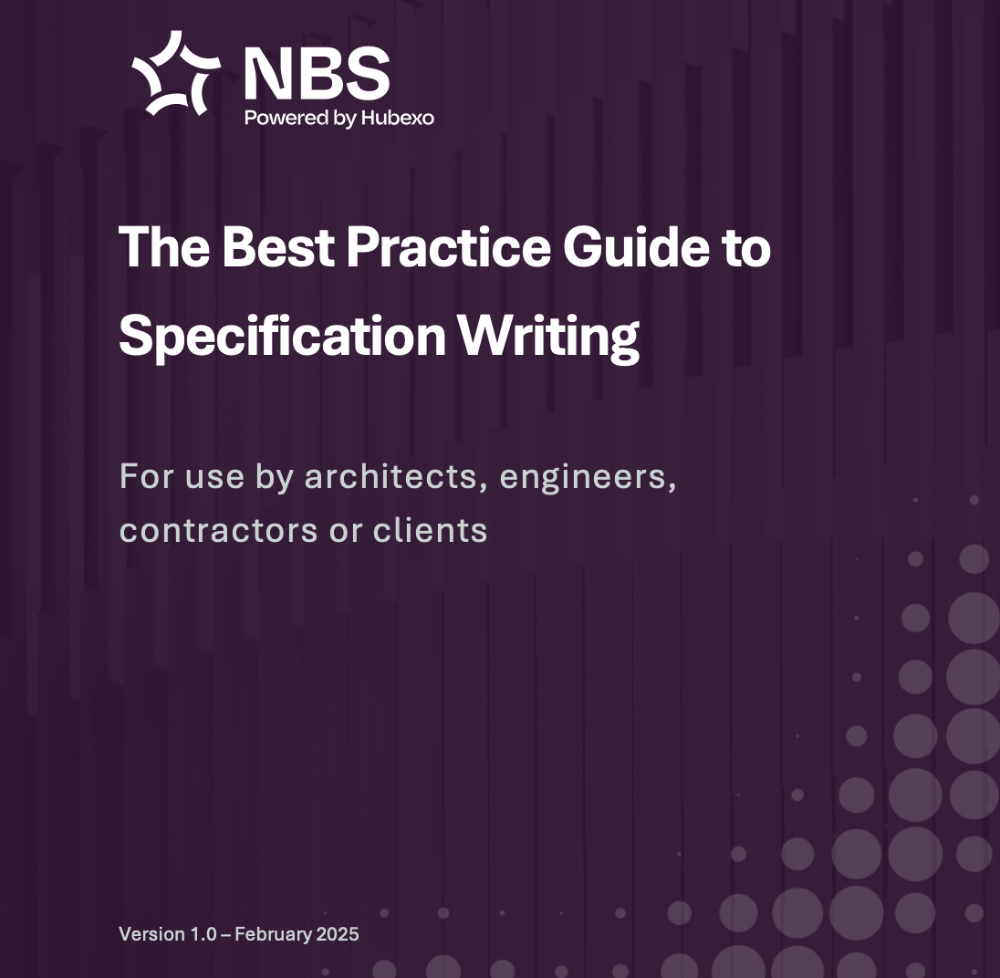NBS launches industry guide for specification writing
NBS (powered by Hubexo), the leading specification platform for the construction industry, launched The Best Practice Guide to Specification Writing, in March 2025. This is a free, comprehensive framework designed to standardise and improve specification writing across the sector. Developed in collaboration with leading industry professionals, the guide addresses common pain points, with the aim to improve consistency and quality in specifications across practices and on contractor-led projects.
Drawing on over 50 years of combined expertise from NBS and NBS Schumann, the guide distils best practice into an accessible, structured resource for architects, engineers, design managers, contractors, professional clients, and students. It provides a clear methodology for writing precise, well-structured specifications - reducing project delays, cost overruns, and compliance risks.
The development of the guide has been industry informed and built for practical use, through industry focus groups where experts highlighted widespread inconsistencies in specification writing and the need for clearer classification and change management processes. As Adrian Shilliday, Technical Director at Galliford Try, says, “Construction projects are becoming increasingly contractor-led, and inconsistency along with lack of cross discipline coordination in specification writing is a growing problem. Poorly written specs can lead to cost overruns, delays, non-compliance with regulations and safety risks. This guide provides a clear framework to prevent those issues.”
The guide is designed to empower industry professionals to write robust specifications, from those starting their careers to more experienced spec writers to reflecting on how they approach specifications. It also complements existing free resources on the NBS website, including sample project specifications.
Dr Stephen Hamil, Innovation Director at NBS and author of the guide, emphasises the document’s role in setting a universal standard: “This is a framework for writing specifications that applies across the industry. Whether you draft specifications in software, Word or on the back of a napkin, the principles remain the same. The goal is to create a standardised approach, ensuring a consistent methodology across practices and clients.”
With regulatory pressures intensifying following the introduction of the Building Safety Act, the industry must improve how it tracks and communicates specification changes. Stephen adds: “As a project progresses, it’s not just about publishing a spec and simply incrementing the revision number. It’s about highlighting precisely what clauses have changed and what those changes are. In addition, bringing as many of the specification decisions forward and ensuring full compliance is the safest route in the current regulatory climate.”
Industry leaders including 3DReid, AHMM, Bowmer + Kirkland, EPR Architects, Galliford Try, Laing O'Rourke and Purcell contributed expertise to ensure the guide reflects real-world challenges and solutions.
The guide is intentionally software-agnostic, allowing organisations to tailor it to their own processes and create a bespoke quality-assurance document. “Transparency in documentation is no longer optional; it’s expected,” says Ruth King, Specifications Lead, Allford Hall Monaghan Morris (AHMM). “Specifications must be clear, verifiable, and aligned with classification systems to ensure efficiency and consistency across teams.”
The guide also addresses manufacturer involvement in specification writing, advocating for early engagement to align product data with project requirements. “Getting manufacturers involved early is crucial. Their input ensures specifications are accurate and meet project needs from the outset,” adds Ruth.
The Best Practice Guide to Specification Writing is available for immediate download here.
This article was issued via press release and appears on the NBS news site as 'NBS launches its back-to-basics industry guide for specification writing' dated 6 March, 2025.
[edit] Related articles on Designing Buildings
- Bill of quantities BOQ
- Commissioning specification.
- Common Arrangement of Work Sections.
- Construction Specifications Canada CSC.
- Construction Specifications Institute CSI.
- Final specifications.
- Functional specification.
- Green Guide to Specification.
- Output-based specification.
- Performance specification.
- Prescriptive specification.
- Specification guidance for construction.
- Specification for construction.
- Schedule.
- Schedule of work for construction.
- Technical specification..
- Tender documentation for construction projects.
Featured articles and news
Gregor Harvie argues that AI is state-sanctioned theft of IP.
Preserving, waterproofing and decorating buildings.
Many resources for visitors aswell as new features for members.
Using technology to empower communities
The Community data platform; capturing the DNA of a place and fostering participation, for better design.
Heat pump and wind turbine sound calculations for PDRs
MCS publish updated sound calculation standards for permitted development installations.
Homes England creates largest housing-led site in the North
Successful, 34 hectare land acquisition with the residential allocation now completed.
Scottish apprenticeship training proposals
General support although better accountability and transparency is sought.
The history of building regulations
A story of belated action in response to crisis.
Moisture, fire safety and emerging trends in living walls
How wet is your wall?
Current policy explained and newly published consultation by the UK and Welsh Governments.
British architecture 1919–39. Book review.
Conservation of listed prefabs in Moseley.
Energy industry calls for urgent reform.
Heritage staff wellbeing at work survey.
A five minute introduction.
50th Golden anniversary ECA Edmundson apprentice award
Showcasing the very best electrotechnical and engineering services for half a century.
Welsh government consults on HRBs and reg changes
Seeking feedback on a new regulatory regime and a broad range of issues.

























